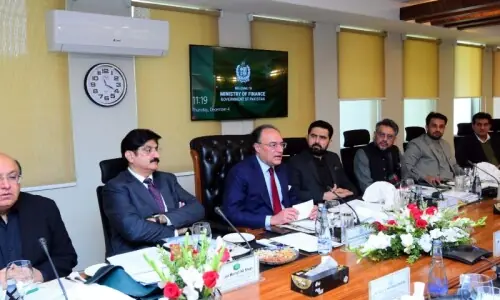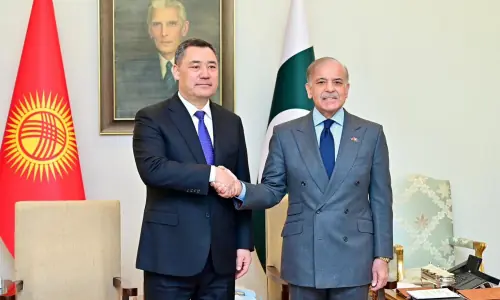ENERGY experts believe that the only solution to the prevalent energy crisis, which is causing electricity shortage of almost one-third of the total demand, is the optimal utilisation of hydropower resources.
To achieve the objective, it is projected that the share of hydropower generation needs to be restored to 70pc in the total energy mix (which was maintained until the 1980s) from the current 32pc.
The development of hydropower, of which Pakistan has huge identified potential, slowed down in the past decades due to a variety of factors. The most important of these were their long gestation periods and the large amount of funding required for developing medium and large projects.
Also read: Germany to lend 40m euros for Warsak power station
It is therefore a step in the right direction to undertake rehabilitation, upgrading, modernisation and capacity expansion of the existing hydropower stations, primarily with a view to achieve designed installed capacity and to optimise water-flow availability. Wapda has already launched rehabilitation projects for Mangla, Tarbela and Tarbela Fourth Extension.
And on July 9, the Executive Committee of the National Economic Council (Ecnec) approved the second rehabilitation project of the Warsak hydroelectric power station, located near Peshawar, at a total cost of Rs23.36bn, including a foreign exchange component of Rs12.18bn.
After the project’s completion (scheduled within seven years), the installed capacity of the powerhouse will be restored to its original designed capacity of 243MW and enable it to generate 1,236GWh of energy.
International financial institutions, including France’s AFD, the European Investment Bank and Germany’s KfW Development Bank, have agreed to finance the project to the tune of 140m euros. In addition, an EU grant of 4.5m euros will be available through the AFD for community development around the project area and for a study of the resilience of the Warsak Dam project to climate change.
Constructed during 1952-1960, the Warsak Dam is the first medium/large multi-purpose hydropower project, having four turbo-generator units of 40MW each and a 132kV transmission system. It was a precursor for the large hydropower stations at Mangla (1968) and Tarbela (1977). Two additional units of 41.48MW capacity each were commissioned at Warsak during 1980-81, resulting in a 243MW cumulative installed capacity.
During these years, the project, which is located on the Kabul River, has largely contributed towards improving socioeconomic conditions of the area through electrification and irrigation. The dam had more than doubled the irrigated area adjacent to the river, providing irrigation diversion for 60,000 hectares.
And while the Warsak power station has been operating largely trouble-free, it has been facing a number of problems since the early days.
One of the major problems is the excessive quantity and abrasive nature of the silt carried by the river water. Operations of the turbo-generating units during the monsoon season with river water, which is laden with silt containing quartz, causes rapid erosion in the hydraulic equipment, which results in severe and chronic operations and maintenance problems.
Remedial measures like regular repairing and rebuilding the worn equipment and replacement of turbine components are therefore adapted. Still, the powerhouse remains vulnerable to frequent breakdowns due to its ageing and obsolescent machinery. Thus, its installed capacity of power station has been de-rated to 210MW, which has necessitated major rehabilitation.
Yet, the Warsak powerhouse plays a critical role in stabilising the voltage of the national grid later in the year when the output from other hydropower stations drop due to decreased water flows from rivers other than Kabul River.
To ensure optimal and reliable functioning of the dam, the rehabilitation project aims to replace four generators, electrical components of four units, all transformers, and install a new Scada system and replace all six runners with erosion-resistant special coating, in addition to civil works. After rehabilitation and upgrading, all the turbo-generating units will be operable for another 30-40 years, well beyond the dam’s designed useful life.
There is structural deformation of the powerhouse due to high sediment concentration of the river water, which results in concrete deformation in the building and the spillway.
Consultancy services for establishing a sustainable sediment management concept for the dam and reservoir and other related activities are being acquired as a major component of the rehabilitation project, for which expressions of interest have been issued by Wapda.
The study, to be completed by 2017, will investigate the present conditions of sedimentation in light of previous studies and propose the adoption of latest methods and techniques to solve the problem. A new 375MW capacity underground power project at the Warsak site has also been planned and its construction is expected to commence next year at an estimated cost of $400m.
And Wapda has already fast-tracked the project, namely the replacement of the crane and the wire-rope spillway hoist, associated civil works and the procurement of a new trash rack cleaning machine.
The political will, however, seems to be lacking. The PC-I for the project was approved by the government after one-and-a-half years. The government will be well-advised to not create any financial or administrative hitches in the effective implementation of the rehabilitation project.
The writer is a retired chairman of the State Engineering Corporation
Published in Dawn, Business & Finance weekly, September 28th, 2015
On a mobile phone? Get the Dawn Mobile App: Apple Store | Google Play


































